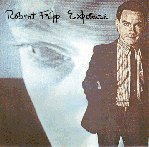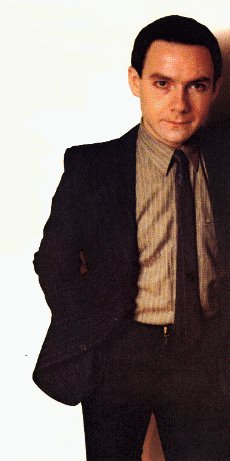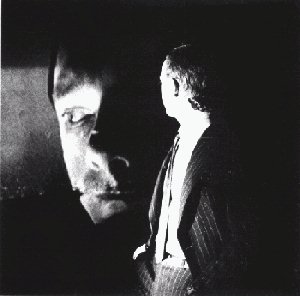

The reason for the partly heavy re-mixing done to the original EXPOSURE
release is unknown to me, and I can only speculate that Robert Fripp was
not satisfied with what the album presented, or how the album presented
it, at the time the respective remixing took place. In effect, the listener
ends up with three different editions of EXPOSURE
that is, the original 1979 release, the 1985 remixed version and the Definitive
Edition. On these pages you will find information on some of the differences
between these releases, as well as Lyrics and
Liner Notes (1979), and some more detailed
information on some aspects of the album compiled from various interviews
and sources.
For a complete list of EXPOSURE-related postings to Elephant Talk you can consult the Crimso Archives Search Engine.
The full text of most of the interviews excerpted here can be found
in the respective ET-digests or in the ET Interview
pages.
EXPOSURE was first published in 1979 accompanied by two promotional releases, NORTH STAR (12") and FOUR FROM EXPOSURE (EP) (for details see John Relph's Robert Fripp Discography).
Two very similar simplistic videos were shot for the title track to
promote the album. These have what became the album cover of the official
release as a back drop with the face in the background moving slightly
(winking, looking about, etc.). In the foreground we have Robert Fripp,
as on the album cover, but walking in and out of the picture, turning toward
the face behind him, etc. Some messages appear on the screen like »The
Drive to 1981.« or »You cannot achieve the aim without suffering.«
It seems that, after so many of the original ideas for EXPOSURE
had to be abandoned, screen shots from these videos were used for the version
that was finally to be released (the liner notes give credits for »VTR
images«). The cover photo for FOUR FROM EXPOSURE
apparently came from the same video sessions.
Originally conceived as part of a trilogy consisting of Daryl
Hall's solo album SACRED SONGS (initially
scheduled for publication in 1977) and Peter
Gabriel's second album (both produced by and with contributions from
Fripp) the project had already undergone heavy changes before its official
release in 1979. One reason for this was the delay of SACRED
SONGS by RCA and Hall's personal management (the album was eventually
published 1979/80), who considered it as too different from Hall's other
works. 
»It terrified the record company« said Fripp in an 1979
Melody Maker interview [Melody Maker, April 28, 1979, Interview by Allan
Jones (MM) Thanks to David Kirkdorffer who supplied this source; full
text]. »Their official description of the record was 'strange.'
They simply refused to release it. The record scared off the company and
his manager.«
When, according to Eric Tamm's book Robert
Fripp: From King Crimson to Guitar Craft (Faber & Faber,
1990), the »real work on [EXPOSURE]
began at the Hit Factory in New York in January 1978« [Tamm, 109]
Daryl Hall was to sing on most of the tracks.
»In September, while already in the process of mastering the
record, Fripp was confronted with contractual problems that prevented Hall
form appearing [...] in such a prominent role« [Tamm, 109]. This
meant that Hall, instead of appearing on some 17 minutes of the album [MM]
was only to sing on two of the tracks and Fripp had to re-work about half
of the album.
Therefore, the version of EXPOSURE finally
published has Hall only on YOU BURN ME UP I'M A CIGARETTE
and NORTH STAR. Further problems arose
when »plans to have Blondie's Deborah Harry
sing a version of Donna Summer's I Feel Love were nixed by Crysalis
Records« [Tamm, 109].
»Thoroughly demoralized and depressed« [MM], Fripp was looking for other suitable vocalists and asked Peter Hammill and Terre Roche to join and sing on the album. Hammill flew into New York, »[...] came into the studio dressed in a rather svelte and smooth fashion, took off his nice cloths and got into a smelly dressing-gown, poured himself liberal dose from the bottle of cognac he'd brought with him, and went in there and started delivering the goods.« [MM]
»What I was trying to do in the original trilogy was to investigate the 'pop song' as a means of expression. I think it's an incredibly good way of putting forward ideas. I think it's a supreme discipline to know that you have three to four minutes to get together all your lost emotions and find words of one syllable or less to put forward all you ideas. It's a discipline of form that I don't think is cheap or shoddy.« [MM]
After the ideas for the original trilogy Hall/Fripp/Gabriel had to be abandoned, Fripp decided to put out a trilogy of solo albums to achieve a similar outcome. In the 1979 Melody Maker Interview he elaborates on the background behind these releases:
»The first album, 'EXPOSURE', is just about to be released. The second album, 'FRIPPERTRONICS', is completed and just has to be assembled. It will be released around September or October this year. I'm currently writing 'DISCOTRONICS' which will probably be released sometime around September 1980.
»'EXPOSURE' deals with tweaking the
vocabulary of, for want of a better word, 'rock' music. It investigates
the vocabulary and, hopefully, expands the possibilities of expression
and introduces a more sophisticated emotional dynamic than one would normally
find within 'rock.'
'FRIPPERTRONICS' deals with expanding
the vocabulary and emotional dynamic of that form of music normally referred
to as Muzak but a better term for it would be Eno's term, ambient music.
»The third album expands the possibilities of disco music as a vehicle for carrying a wider range of propositions than normally one would expect. 'DISCOTRONICS' is officially defined as the musical experience resulting at the interstice of disco and Frippertronics.« [MM]
Unfortunately, none of this was to go as planned either, which resulted in the UNDER HEAVY MANNERS/GOD SAVE THE QUEEN, LEAGUE OF GENTLEMEN and LET THE POWER FALL sequence of albums as published during the late seventies and early eighties. In retrospect, however, Fripp seemed contented with the final outcome of the published album: »As it turned out it worked. I'm very happy with a number of singers, different personal voices within myself acting vicariously.« [Recorder III, 1981, full text here].
An interview Fripp gave to Caroline Coon for Sounds in September
1978, prior to the then scheduled release of the album on October 16th,
gives an idea of the EXPOSURE Fripp seems
to have been after [I have not yet been able to find the original, full
interview (can anybody help?) and have used the excerpts posted to ET
(213) by Barrie Sillars].
According to this the original album title was to be »THE
LAST GREAT NEW YORK HEART-THROB« and BrianEno,
»who [was] drawing the cover«(!), later suggestedto call it
»EXPOSURE«. Fripp gives the following
outline:
![]()
Side One.
Side Two.
Back to BREATHLESS description
![]()
According to Eric Tamm the original album cover was to contain a photograph of Fripp »with the Rockettes at Radio City Music Hall« [Tamm, 109], an idea which is almost the opposite of the rather somber album cover which we know. In an interview given 1981 to the Bristol magazine RECORDER (full text here), Fripp talks about the concept behind the released EXPOSURE album:

»The album itself, musically, brought everything I'd done up to that point together and it was essentially an M.O.R. album. It was a kind of autobiography on three levels: one was the day-to-day life and the stuff that happens - you're dreaming, the telephone goes off, you have an argument with the woman you're living with, you rush off to work, your mother phones you up and bends your ear, and finally at the end of the album you calm down and go to sleep again, and go out in dreams. So that's that level, the other is that it's an investigation of internalized family archetypes, psychological archetypes; 'Disengage' is a kind of rock version of 'Schizophrenia Madness in the Family' [...], the basic premise of [that] book is that schizophrenia (which has never been clinically defined) is where the family makes the person feel crazy. [...] That's the other level; and the third is, of course, that it had to do with starting some kind of inner development, and the commitment to work and that it's impossible to achieve the aim without suffering; the aim is freedom, conscience and truth, in Bennett's words - that comes from the first inaugural address to Sherborne House.« [Recorder III]
Hence, the first release of EXPOSURE had the quote engraved on the inner groove of its side two: THE AIM IS FREEDOM CONSCIENCE AND TRUTH.
JOHN G. BENNETT (1897 - 1974) is rather prominent on the tape splicings that pop up on EXPOSURE. Roughly speaking, one could say that Bennett was, among other things, one of the foremost pupils (for want of a better word) of G.I. GURDJIEFF (1877(?) - 1949), taking further »The Work«, Gurdjieff's system of self-development.
GEORGE IVANOVITCH GURDJIEFF was a spiritual/philosophical teacher who had come to Central Europe during the Russian Civil War, after plans to set up an Institute for the Harmonious Development of Man in the Caucasus region had to be abandoned. His initial idea of setting up the institute in Germany did not work out either, so that by 1922 the whole project was moved to the Prieuré at Fontainebleau near Paris, France. Also among Gudjieff's followers was composer THOMAS DE HARTMANN, a close friend of Russian composer ALEXANDER SKRJABIN, whose unusual theories about music (IMO) provide a link that it would be interesting to explore further. The music of Gudjieff and de Hartmann is available in several recordings and interpretations. One of the better known interpreters being pianist Keith Jarrett, Aparently, there also seems to have been a recording by Elan Sicroff which Robert Fripp produced but which I have never been able to locate.
After the war and after Gurdjieff's death in 1949, several Gurdjieff pupils set out to continue with »The Work«, which at some point resulted in Bennett founding the Academy for Continuous Education in Britain. In 1971 the Society finally settled at Sherborne House, Gloucestershire, where in the mid-seventies Robert Fripp attended a one year course.
According to his own comments, the experiences at Sherborne dramatically changed Fripp's life, and naturally, from that point on, ideas from the Gurdjieff/Bennett philosophical school are traceable in Fripp's work. Fripp's involvement with the Society for Continuous Education (see below), who after 1976 had moved to Claymont, in the US, included fund raising for the Claymont Children's School with the production of THE LADY OR THE TIGER? and the production of lectures for the Bennett Tape Library.
In an interview with Ron Gaskin from the time of the EXPOSURE »non-tour« [submitted to ET by JPRICE at TrentU dot ca (full text here)] Fripp explains that »Bennett's statements came from a series of cassettes, mainly taken from cosmological and psychological lectures Bennett gave at Sherborne House, the school I went to in England, the International Academy for Continuous Education.«
The inclusion of these taped bits - notably also on the original LEAGUE OF GENTLEMEN album and the collaborations on David Sylvian's GONE TO EARTH - is closely linked to the idea of »AUDIO VERITE;«. Audio verité is the frippism for an approach to production Fripp had come to favour in the late seventies and used on a couple of projects, like the ROCHES' self titled album and PETER GABRIEL II. In the interview Fripp explains the approach: »[...] there's two senses to audio verite. The first is that it's a commitment to discover whatever the essence of the artists might be and try and express it on record. And this is done in the second sense of the term by, as far as possible, not interfering with the performance by equalization, limiting and so on.« And he continues that »the main premise of the second aspect of audio verite [is], that too much technology gets in the way. All that one needs is a small and appropriate level of technology.«
He further states that »in fact, most of the voices on EXPOSURE were recorded on my small pocket Sony cassette machine.« Refering to this Fripp explains: »The passages I recorded were Eno in the falafel restaurant. Eno introduces the record and it's Eno finishing talking about the hoax. I recorded my mother at the beginning of Disengage, since it's a song about internalized parental archetypes and since many schools of personality formation attribute considerable importance to toilet training, I interviewed my mother on the subject of my toilet training and included that at the beginning of the song. And also the argument next door on NY3 which is a real-life argument next door when I was living in Hell's Kitchen in New York. [...] Terrifying. You should have heard the rest of it. I recorded about ten minutes and you only heard odd phrases. But some of the things they were saying to each other... And bear in mind that I had ten minutes. There had been an hour-and-a-half before I started recording of equal virulence. They kept that up for an hour-and-a-half without any abatement. Terrifying ... terrifying. The nuclear family in New York City. The NY3.«
The rest of the story is told quickly. During 1985 EXPOSURE, among other albums, was »remixed to Sony digital stereo system« [Liner Notes, 1985], i.e. altered considerably. The album that emerged from that process was again »re-mastered« for the Definitive Edition, and surprisingly these two versions are roughly, but not fully identical. You will find a listing of the differences, together with some more details on the tracks on a separate Page. The original 1979 Liner Notes are below. Enjoy.
Back to the Top
This album was originally conceived as the third part of an MOR trilogy with Daryl Hall's solo album Sacred Songs and Peter Gabriel II both of which I produced and to which I contributed. With the non-release of Sacred Songs and the delay by dinosaurs of this album it is impossible to convey the sense which I had intended.
Instead Exposure is now the first part of my own series and will shortly be followed by »Frippertronics« and »Discotronics« . Taken together these should provide an overview different in kind but similar in nature to that of my original intention.
Recorded mainly and mixed entirely at The Hit Factory, New York between
January 1978 and January 1979.
Engineer: Ed Sprigg
Assistant Engineers: Jon Smith, Michael Ruffo, David Prentice
Track for »Exposure« recorded at Relight Studios, November
1977.
Engineer: Steve Short
Track for »Here Comes The Flood.« Engineer: Steve Short
»Water Music II« recorded at The House of Music, New Jersey,
July 1977.
Engineer: Jim Bonneford
N.B. Ms. Roche's voice on »Exposure« was Fritched.
All Frippertronics other than »Water Music II« - recorded
at the Fripp Mobile in the Lower East Side, Upper East Side, Hell's Kitchen
and the West Village of New York between June 1977 and November 1978. Engineer:
Fripp.
The album of pure Frippertronics for release in September 1979 is drawn
mainly from these recordings.
Location recordings mainly at W. 51st and the West Village.
Obviously, no one location was sufficient to contain all the action
described within this record.
®1979 E.G. Records Ltd.
Contributors:
Barry Andrews (courtesy of Virgin Records)
Phil Collins (courtesy of Charisma Records)
Brian Eno
Robert Fripp
Peter Gabriel (courtesy of Charisma Records)
Daryl Hall (courtesy of RCA)
Peter Hammill (courtesy of Charisma Records)
Tony Levin
Jerry Marotta
Sid McGinness
Terre Roche (courtesy of Warner Bros.)
Narada Michael Walden (courtesy of Atlantic Records)
And the voices of (among others)
Shivapuri Baba (courtesy of Mrs Elizabeth Bennett)
J.G. Bennett (courtesy of Mrs Elizabeth Bennett)
Mrs Edith Fripp
Mrs Evelyn Harris
Album Cover:
Chris Stein: design and photography:
Steve Sprouse: colorist
Amos Poe: VTR images
Thanks to Mick and Ernie
Mary Lou Green: hair
Cream: typography
This Fripp is indebted to all those who took part in the hazardous series of events culminating in this record, and several who do not appear but who helped determine the final shape: Tim Cappella, Alirio Lima, Ian MacDonald and John Wetton. For the enthusiasm of all involved, thank you. Additional gratitude to Paul Higgins for equipment, moving and kitchen support; Charlene, Walter and the perennial Dik Fraser; latterly Ann and Ed; Managers Mark and Sam for following despite disbelief, to Brian Eno for generously introducing me to the technology of skysaw guitar and the tape system which enabled the development of Frippertronics and for advice; Joanna Walton for her unerring criticism and sense of the appropriate; the Fripp family for withstanding my investigation of family customs; and J. G. Bennett for infinitely more than words could repay.
This Fripp is not available for personal correspondence but is contactable via: E.G. Records Inc, 246 E. 62 St. N.Y., N.Y. 10021 E.G. Management Ltd., 63a Kings Road, London 5W3 4NT. ©1979 E.G. Records Ltd.
Side One
1. Preface (Fripp)
2. You Burn Me Up I'm A Cigarette (Fripp/Hall)
3. Breathless (Fripp)
4. Disengage (Fripp/Hammill/Walton)
5. North Star (Fripp/Hall/Walton)
6. Chicago (Fripp/Hall/Walton)
7. NY3 (Fripp)
8. Mary (Fripp/Hall/Walton)
Side Two
1. Exposure (Fripp/Gabriel)
2. Häaden Two (Fripp)
3. Urban Landscape (Fripp)
4. I May Not Have Had Enough Of Me But I've Had Enough Of You (Fripp/Walton)
5. First Inaugural Address To The I.A.C.E. Sherborne House (Bennett)
6. Water Music I (Fripp/Bennett)
7. Here Comes The Flood (Gabriel)
8. Water Music II (Fripp)
9. Postscript (Fripp)